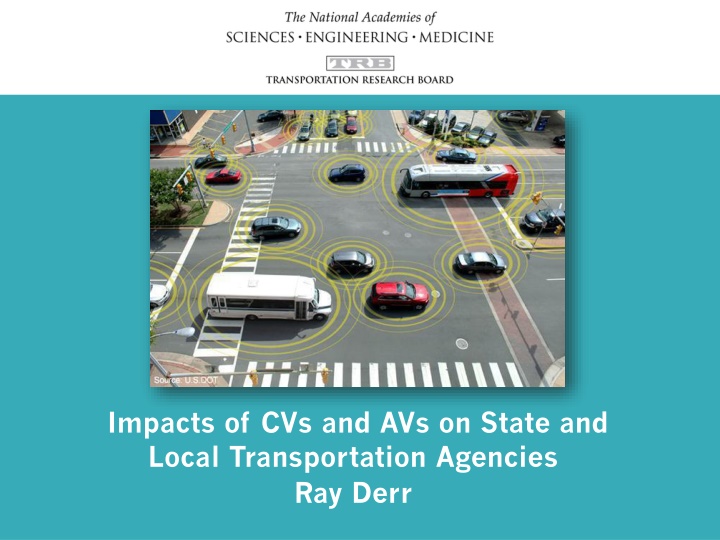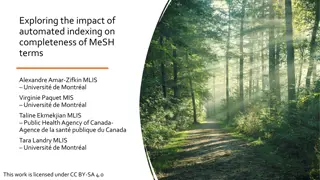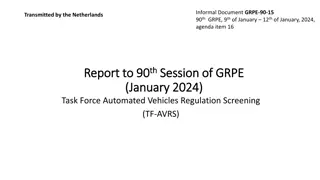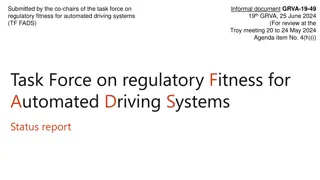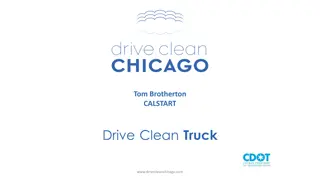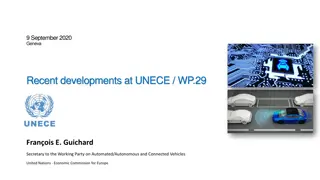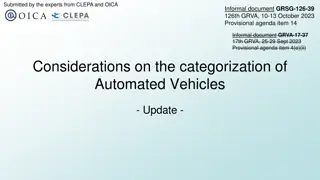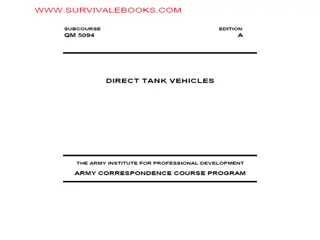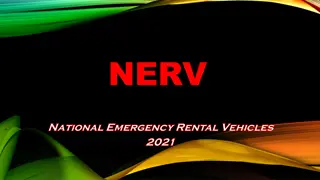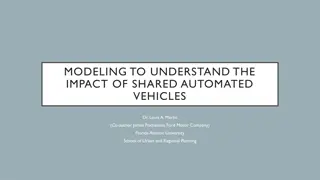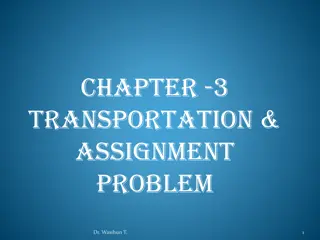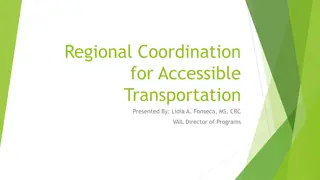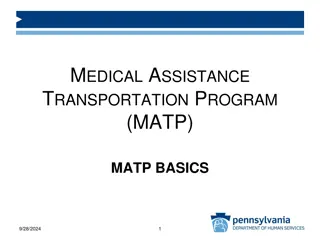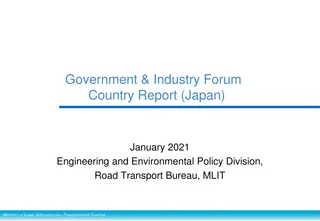Impacts and Research on Automated Vehicles in Transportation Agencies
This comprehensive content discusses the impacts of connected and automated vehicles (CAVs) on state and local transportation agencies, highlighting research initiatives such as the National Cooperative Highway Research Program (NCHRP). Various tasks and panels are outlined, addressing policy actions, technology introduction, and challenges in implementing CAV systems in transit and freight operations.
Download Presentation

Please find below an Image/Link to download the presentation.
The content on the website is provided AS IS for your information and personal use only. It may not be sold, licensed, or shared on other websites without obtaining consent from the author.If you encounter any issues during the download, it is possible that the publisher has removed the file from their server.
You are allowed to download the files provided on this website for personal or commercial use, subject to the condition that they are used lawfully. All files are the property of their respective owners.
The content on the website is provided AS IS for your information and personal use only. It may not be sold, licensed, or shared on other websites without obtaining consent from the author.
E N D
Presentation Transcript
https://g.foolcdn.com/editorial/images/158056/nhtsa1_large_large_1_large_large.jpghttps://g.foolcdn.com/editorial/images/158056/nhtsa1_large_large_1_large_large.jpg Impacts of CVs and AVs on State and Local Transportation Agencies Ray Derr
Questions What does my agency need to install for V2I? When can we stop installing or doing other things? When will automated vehicles begin to affect the transportation system? Can the public sector influence the course of events? What should we be doing now?
National Cooperative Highway Research Program (NCHRP) Pooled fund program through voluntary contributions by state DOTs--$40M/year Applied research on national, shared issues Partnership between Sponsored and directed by American Association of State Highway and Transportation Officials Managed by the Transportation Research Board Assisted by FHWA
NCHRP CV/AV Research Roadmap Over 100 issues facing state and local agencies identified and prioritized 23 problem statements developed ($15M) Roadmap available at http://trb.org
Impacts of CVs and AVs on State and Local Transportation Agencies [NCHRP 20-102] NCHRP Project 20-102 approved in Dec 2014 $2M authorized to-date; additional $3M hoped for in future years Panel decides which tasks to pursue, principally from the research roadmap
NCHRP 20-102 Panel Kazem Farhoumand, RI DOT Shailen Bhatt, CO DOT Giovanni Circella, GA Tech David Huft, SD DOT Ed Hutchinson, FL DOT Sherif Ishak, LSU Melissa Lance, VA DOT Greg Larson, CA DOT Jerome Lutin, Consultant Siva Narla, ITE Tom Schaffnit, VII Consort. Michael Shulman, Ford Matt Smith, MI DOT Paul Trombino, IA DOT Emil Wolanin, Montgomery Co. (MD) Volker Fessmann, FHWA Kevin Dopart, U.S. DOT Anita Kim, Volpe Jennifer Carter, ITS America Gummada Murthy, AASHTO Mark Norman, TRB
Active Tasks for NCHRP 20-102 Policy and Planning Actions to Internalize Societal Impacts of CV and AV Systems into Market Decisions (Task 01) Impacts of Regulations and Policies on CV and AV Technology Introduction in Transit Operations (Task 02) Challenges to CV and AV Applications in Truck Freight Operations (Task 03)
Upcoming Tasks for NCHRP 20-102 Evaluation Guidance for AV Pilot and Demonstration Projects (Task 04) Strategic Communications Plan (Task 05) Road Markings for Machine Vision (Task 06) Implications of Automation for Motor Vehicle Codes (Task 07) Dedicating Lanes for Priority or Exclusive Use by CVs and AVs (Task 08) Providing Support to the Introduction of CV/AV Impacts into Regional Transportation Planning and Modeling Tools (Task 09)
Collaboration Efforts Important to Avoid duplication of effort Leverage resources Key partners U.S. DOT CV Pooled Fund Study V2I Deployment Coalition Crash Avoidance Metrics Partnership Various AASHTO and TRB Standing Committees Conference of European Directors of Roads
Timeliness Efforts Typical public sector research processes are not considered speedy nor nimble Value of products will rapidly decay Tweaking NCHRP processes to maintain quality while improving timeliness Regular updating of research roadmap Task-order contracts Interim materials will be made available
Implementation Efforts Strategic Communications Plan (Task 05) Leadership through V2I Deployment Coalition CV Pooled Fund Study AASHTO TSM&O Committee National Operations Center of Excellence (http://transportationops.org)
V2I Deployment Coalition Began May 2015 as a joint effort of AASHTO, ITE, and ITS America; supported by FHWA Help accelerate consistent and effective deployments of CV technologies that address passenger vehicles, freight, and transit operations, urban and rural Five working groups: Deployment Initiatives, Research, Partners, Standards, & Guidance Four Initial Crosscutting Issues: V2X Applications, Benefits & Costs, V2I Data, & V2I Outreach Meeting Apr 20-21, Ann Arbor, MI For more info, contact King Gee, kgee@aashto.org
CV Pooled Fund Study Member DOTs are AZ, CA, MI, MN, FL, NJ, NY, PA, TX, UT, VA, WA, WI, Maricopa County, & FHWA Biannual Meetings Research Efforts Basic Infrastructure Message Multi-Modal Intelligent Traffic Signal System Best Practices for Surveying/Mapping Roadways and Intersections for CV Applications DSRC Vehicle-Based Road and Weather Condition TMCs in a CV Environment For info, Melissa Lance (melissa.lance@vdot.virginia.gov)
2016 Automated Vehicle Symposium Jul 19-21, San Francisco 870 participants in 2015, mostly private sector Public sector has played a larger role in the last two symposia
Institutional and Policy Business models for infrastructure deployment Public policy actions to facilitate implementation Implications of AV for motor vehicle codes Harmonization of state goals and regulations Fed/state/local responsibilities Lessons learned from Safety Pilot and CV Pilots Lessons learned from other tech rollouts (e.g. 511, Next Gen air traffic control)
Infrastructure Design/Operations Dedicated lanes for CV/AV Roadway geometric design Cybersecurity for state and local agencies Workforce capability strategies Management of Big Data Road infrastructure design Tools for CV/AV impact assessment CV/AV maintenance fleet apps Relationships of CV to AV Traffic control strategies
Transportation Planning AVs and regional long-term planning models Assessing impacts of CV/AV (applying tools to test cases) Modeling effects of AV/CV on land use and travel demand
Modal Applications Impacts of transit regulations on AV/CV tech introduction Next steps for AV/CV applications to long-haul freight Benefit/cost analysis of AV transit systems
Policy and Planning Actions to Internalize Societal Impacts of CV and AV Systems into Market Decisions Objective: Identify and describe policy and planning actions at the state, regional, and local levels that could help societal impacts (including impacts on transportation system owner/operators) of CV and AV technologies to be internalized in market decisions made by individuals and organizations.
Impacts of Regulations and Policies on CV and AV Technology Introduction in Transit Operations Objectives: 1. Describe the current regulatory and policy landscape of transit system planning, development, funding, implementation, and operations that could impact the introduction of CV/AV technologies 2. Describe regulatory and policy changes that may be needed to facilitate the enhancement of existing, and implementation of new forms of public transportation enabled by various CV/AV technologies 3. Identify and discuss the implications of CV/AV technologies for stakeholders involved in the governance and regulation of public transportation
Challenges to CV and AV Application in Truck Freight Operations Objectives: 1. Identify and describe existing and emerging freight regulatory, planning, policy, and operational environments and challenges for connected and autonomous truck technologies. 2. Identify public and private sector barriers to, and opportunities for implementation of these technologies in freight operations 3. Propose next steps for addressing the challenges for deployment and adoption
Dedicating Lanes for Priority or Exclusive Use by CVs and AVs Objective: Develop guidance on identifying and describing conditions amenable to dedicating lanes for CV/AV users. The guidance should also identify current laws and regulations that constrain the ability to take those actions. The deliverables should describe how to measure benefits to CV/AV users in the dedicated lanes, and operating agencies, as well as possible dis-benefits to non-users and affected agencies as a function of market penetration and other relevant factors. This work should be coordinated with and build on work underway by the Crash Avoidance Metrics Partnership (CAMP) on cooperative adaptive cruise control, as well as complementary work currently underway at the FHWA.
Providing Support to the Introduction of CV/AV Impacts into Regional Transportation Planning and Modeling Tools Objective: Provide a conceptual framework and applicable guidelines to support state DOTs and regional MPOs as they explore, assess, update, and augment as necessary their planning, modeling, and forecasting tools to address potential effects of AV and CV on transportation supply, capacity, and travel demand.
